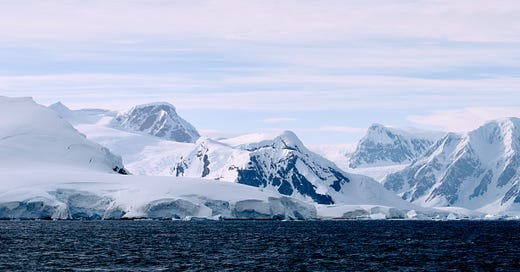Cool Currents: How Antarctic Meltwater Is Changing New Zealand’s Climate Forecast
Melting Antarctic ice is quietly reshaping the winds, waters, and weather near New Zealand—with major implications for global climate projections.
Breaking the Ice:
A new study has provided the first quantitative assessment of how meltwater from the Antarctic Ice Sheet (AIS) affects New Zealand’s climate. Conducted by an international team of scientists, the research notably incorporated meltwater dynamics often excluded from mainstream projections.
In both historical (1992–2020) and future (through 2100) high-emissions scenarios, the study finds that Antarctic meltwater causes significant cooling of the sea surface southeast of New Zealand, particularly in winter and spring. This cooling shifts the Subtropical Front (a major ocean current boundary) northward and intensifies westerly winds south of the country.
Although the direct land-based climate effects for New Zealand are modest, these oceanic shifts could have significant regional consequences—particularly for marine ecosystems and future climate modeling efforts. The report makes a compelling case: to ignore Antarctic meltwater in climate projections is to risk misrepresenting future environmental and atmospheric conditions.
Quick Melt:
The implications of these findings extend beyond a single country’s shores. As global warming intensifies, the AIS is expected to lose more mass—releasing vast volumes of freshwater into the Southern Ocean. This influx of meltwater not only cools surface temperatures but disrupts ocean circulation and atmospheric patterns in a region that serves as a climatic crossroads.
A particularly consequential result of the cooling is the offsetting of the anticipated southward migration of the Subtropical Front due to warming. This front defines the boundary between warmer subtropical and cooler subantarctic waters. Its position influences nutrient distribution, ocean productivity, and even fisheries. By partially reversing this shift, the AIS meltwater could unexpectedly alter marine ecosystems and food webs critical to New Zealand’s economy and biodiversity.
Another major finding is the projected strengthening of wintertime westerlies south of New Zealand. These intensified winds are driven by sharper temperature gradients between polar and subtropical waters, reinforcing a feedback loop. Stronger westerlies can enhance ocean mixing and further influence current dynamics and climate variability—especially in the Southern Hemisphere.
Though modest reductions in extreme heat days were noted over New Zealand’s North Island (about two fewer annually by 2100), the researchers caution that the meltwater’s most dramatic effects are likely to manifest at sea. This, they argue, underscores a larger issue in climate modeling: the exclusion of Antarctic meltwater leads to an underestimation of regional climate variability and marine system responses.
The Thaw:
What is the Influence of Antarctic Meltwater Around the Globe? AccumulationZone Explains.
At the heart of this study lies the concept of freshwater forcing—how the injection of low-salinity water (from melting ice) alters ocean circulation. When freshwater enters the Southern Ocean, it changes the water’s density and reduces its ability to sink—a process that would typically drive deep-ocean currents critical to global heat and carbon transport. This, in turn, changes surface temperature distributions and affects atmospheric circulation.
One key area impacted is the Subtropical Front (STF), a major boundary where warm northern waters meet cold southern ones. Its location can shift due to both natural variability and anthropogenic forces. In a warming climate without meltwater input, the STF is expected to migrate southward, pushing warmer conditions poleward. But when Antarctic meltwater is added to models, this migration is partially reversed—effectively anchoring the STF farther north and cooling adjacent waters.
Temperature and salinity gradients across the STF influence marine productivity, oceanic nutrient mixing, and biogeochemical cycles. For example, cooler waters brought northward could enhance productivity in regions that might otherwise see declines. Conversely, shifts in current pathways like the East Australian Current—implicated in transient warming near Tasmania—demonstrate how meltwater can ripple across ocean basins.
Atmospherically, meltwater-induced cooling sharpens the contrast between equatorial and polar temperatures, which in turn strengthens westerly wind belts. These winds govern storm tracks and jet streams, which affect everything from precipitation patterns to ocean swell directions. As a result, even seemingly small changes in meltwater flux can tip regional climate systems into new regimes.
Final Thoughts
For countries like New Zealand, climate projections can’t afford to ignore what’s happening farther south. This research is a stark reminder that global warming is not a uniform process—it cascades unevenly through Earth’s systems, and sometimes, the coldest waters hold the hottest consequences.


